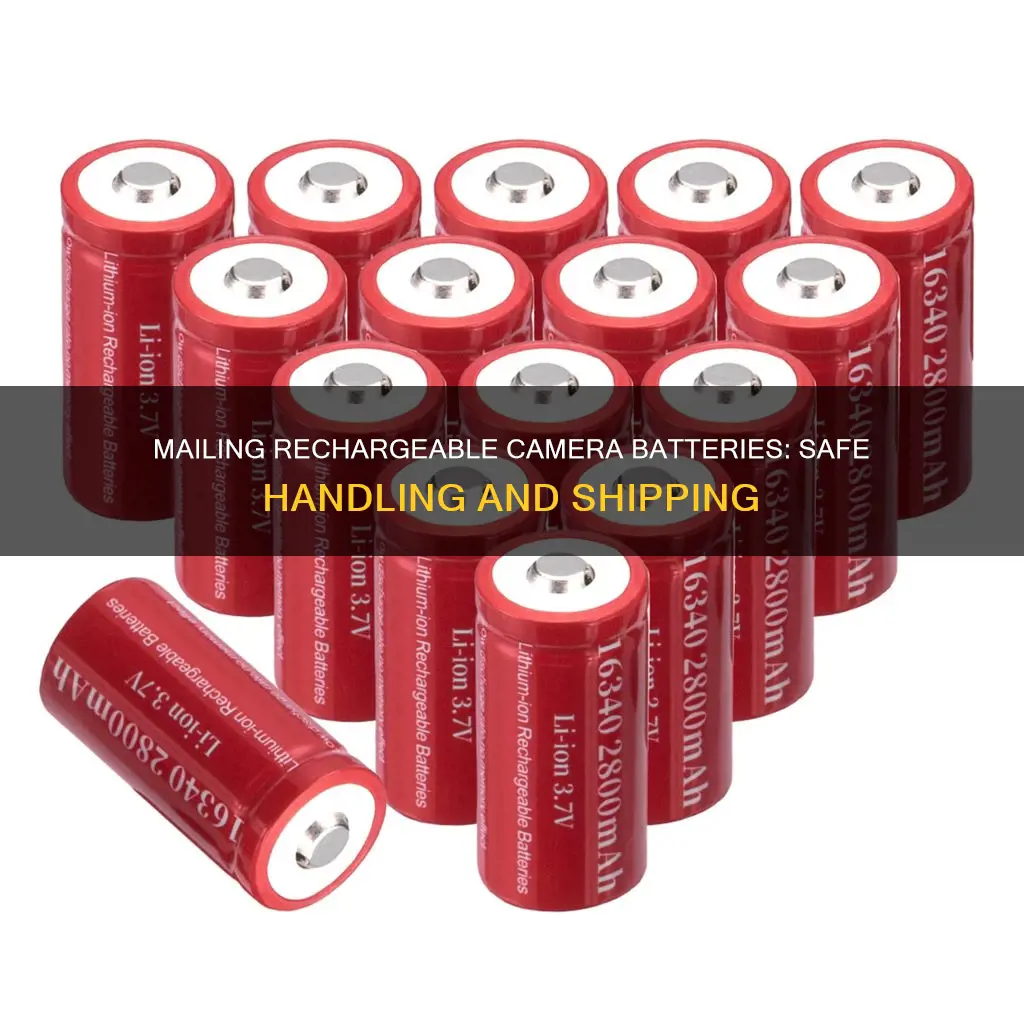
Mailing rechargeable camera batteries can be a complicated process due to safety concerns. Lithium batteries, which are commonly used to power cameras, are highly flammable and can pose a safety risk if not handled properly. To ensure safe transport, it is important to follow guidelines and regulations set by postal services and government organizations. These regulations include specific packaging and labelling requirements, such as using strong and sealed packages to prevent movement and including a Dangerous Goods label. Some couriers may also require additional documentation, such as a Material Safety Data Sheet or a UN38.3 Certificate. It is crucial to comply with these regulations to avoid potential fines and tragic consequences, such as fires or accidents during transport.
| Characteristics | Values |
|---|---|
| Battery type | Lithium-ion (rechargeable) |
| Battery weight | Less than 35 kg |
| Battery charge | Less than 30% of full capacity |
| Packaging | Rigid, sealed, cushioned, strong enough to prevent crushing and exposure of contents |
| Labels | Lithium battery mark, telephone number, "Surface Mail Only, Lithium-ion Batteries — Forbidden for Transportation Aboard Passenger Aircraft", "Package Contains Lithium-ion Batteries (no lithium metal)", "Restricted Electronic Device", "Surface Transportation Only" |
| Shipping | Domestic only, no international shipping |
What You'll Learn
- Use a reputable courier with trained personnel who understand how to handle lithium batteries
- Ensure the package is strong enough to prevent crushing and exposure of the contents
- Label the shipment to indicate it contains lithium batteries or dangerous goods
- Don't send damaged or defective batteries
- Use specialised packaging to prevent short-circuiting

Use a reputable courier with trained personnel who understand how to handle lithium batteries
When mailing rechargeable camera batteries, it is important to use a reputable courier with trained personnel who understand how to handle lithium batteries. These personnel should be well-versed in the detailed regulations that must be complied with to ship these batteries safely.
Lithium batteries are classified as dangerous goods, and their mishandling can lead to safety risks, including fires. Therefore, it is crucial to select a courier service that specialises in shipping dangerous goods and has experience in handling lithium batteries. Reputable couriers will have guidelines in place for shipping these items, ensuring that they are correctly declared, packaged, labelled, and stored.
Before choosing a courier, it is advisable to research their safety record and read reviews from previous customers. It is also essential to familiarise yourself with the specific requirements and restrictions outlined by the courier, as these may vary. For example, some couriers may require you to sign a separate contract for shipping lithium batteries, while others may have weight restrictions or prohibit certain types of batteries altogether.
By selecting a reputable courier with trained personnel, you can have peace of mind knowing that your shipment will be handled securely and in compliance with all applicable regulations. This will help ensure that your rechargeable camera batteries arrive safely at their destination without posing any risks during transportation.
Charging Your A6000: A Step-by-Step Guide to Powering Your Camera
You may want to see also

Ensure the package is strong enough to prevent crushing and exposure of the contents
When mailing rechargeable camera batteries, it is important to ensure that the package is strong enough to prevent crushing and exposure of the contents. Here are some detailed instructions to help you with this:
Firstly, consider the weight of your rechargeable camera batteries and choose an appropriately strong box. You can refer to the Edge Crust Test (ECT) rating, which measures the cross-section crushing of corrugated cardboard in relation to its stacking strength. For example, a box with a 32 ECT rating can withstand 32 lbs of pressure when stacked.
Additionally, you can refer to the Mullen test (also known as the burst test or pop test), which uses a hydraulic device to measure the force required to warp or burst the corrugated sheet. This indicates how well the box will withstand rough handling during transit.
When selecting a box, ensure it is made of sturdy corrugated cardboard and is free from any damage or weaknesses that could compromise its integrity. The box should be new or like new, with no punctures, tears, or corner dents. It should also be large enough to accommodate the batteries and any additional cushioning or packaging.
Once you have selected an appropriate box, it is crucial to properly cushion and secure the rechargeable camera batteries inside. Use protective packaging materials such as paper-based dunnage, air pillows, bubble wrap, or foam-in-place solutions to fill any voids and prevent the batteries from shifting during transport. Ensure the cushioning material is thick enough to provide adequate protection.
After placing the batteries in the box and adding cushioning, seal the box securely. Use strong packaging tape specifically designed for shipping, and avoid using string or paper over-wrap. Clearly and correctly label the package, following the guidelines provided by the shipping carrier, such as USPS.
By following these instructions, you can help ensure that your package is strong enough to prevent crushing and exposure of the rechargeable camera batteries during transport.
Charging Your Bird Buddy Camera: A Quick Guide
You may want to see also

Label the shipment to indicate it contains lithium batteries or dangerous goods
When shipping rechargeable camera batteries, it is important to label the shipment to indicate that it contains lithium batteries or dangerous goods. This is a requirement by the U.S. Department of Transportation (DOT) and the U.S. Postal Service (USPS) for the safe transportation of lithium batteries. The labels must adhere to the DOT-approved lithium battery marks specified in 49 CFR 173.185(c)(3)(i) and Exhibit 325.2a.
The specific label requirements depend on whether the lithium-ion batteries are installed in or packed with the equipment they are intended to operate. If the batteries are installed in the equipment, the label must indicate "UN3481 for lithium-ion cells or batteries installed in equipment". If the batteries are packed with the equipment, the label must indicate "UN3481 for lithium-ion cells or batteries packed with equipment". In both cases, the label must also include a telephone number for additional information.
If you are shipping individual lithium-ion batteries without any equipment, the label must indicate "UN3480 for lithium-ion cells or batteries". Additionally, the label must include a telephone number for further information, and the package must be marked as "Surface Mail Only, Lithium-ion Batteries — Forbidden for Transportation Aboard Passenger Aircraft".
It is important to note that these labelling requirements are mandatory and must be followed to ensure compliance with safety regulations. Failure to properly label shipments containing lithium batteries can result in fines and other serious consequences.
Charging the Fujifilm FinePix 10 X Wide: A Step-by-Step Guide
You may want to see also

Don't send damaged or defective batteries
When mailing rechargeable camera batteries, it is important to adhere to safety guidelines to ensure that you are not putting yourself or others at risk. One crucial instruction is to refrain from sending damaged or defective batteries. This instruction is not merely a suggestion but a mandatory requirement, as these batteries are deemed hazardous and require special handling.
Damaged or defective lithium-ion and lithium-metal batteries are of particular concern due to their high energy density. If they short circuit, they can generate extreme heat and are prone to "thermal runaway," leading to a self-perpetuating cycle of increasing temperature and fire. This makes such batteries extremely challenging to extinguish. Therefore, it is essential to identify signs of damage, such as swelling, corrosion, leakage, or burn marks, and refrain from mailing batteries exhibiting these issues.
Additionally, defective batteries may not always display visible changes but can still be identified by the manufacturer as underperforming or unsafe. Recalled batteries fall into this category, and they are often classified by model, serial number, batch, or lot. Manufacturers initiate recalls when batteries do not meet performance expectations or pose potential safety hazards. Even if no visible damage is apparent, it is crucial to follow the manufacturer's instructions for disposal and replacement in such cases.
When dealing with damaged or defective batteries, it is imperative to package them securely. Place the battery or device in a non-flammable material, such as sand or kitty litter, as soon as possible. Avoid disposing of these batteries in the trash or regular recycling containers to prevent safety hazards like sparks or fires.
To summarise, damaged or defective batteries should never be sent via mail due to their hazardous nature. Proper handling and disposal methods, such as those outlined above, must be followed to ensure the safety of all involved in the shipping process.
Is Your Webbie HD Camera Charging?
You may want to see also

Use specialised packaging to prevent short-circuiting
When mailing rechargeable camera batteries, it is important to use specialised packaging to prevent short-circuiting. This is a requirement shared by all regulations pertaining to the transport of lithium cells and batteries. Here are some ways to ensure your packaging is specialised to prevent short-circuiting:
- Use fully enclosed inner packaging made of non-conductive material, such as plastic bags, to pack each battery or battery-powered device.
- Separate or pack batteries to prevent contact with other batteries, devices, or conductive materials (e.g. metal) within the packaging.
- Protect exposed terminals or connectors with non-conductive caps, non-conductive tape, or other appropriate means.
- Ensure that battery terminals are protected from damage. If the outer packaging is not impact-resistant, do not rely on it solely to protect the battery terminals.
- Securely cushion and pack the batteries to prevent shifting, which could loosen terminal caps or reorient terminals and cause short-circuiting.
- Use rigid plastic packaging or construct the battery with recessed terminals to prevent damage to the terminals if the package is dropped.
- Attach covers securely to protect the terminals, ensuring they have sufficient strength.
In addition to these measures, you should also follow other guidelines for safely mailing rechargeable camera batteries. These include using strong outer packaging to prevent crushing and exposure of contents, affixing the appropriate labels, and adhering to weight and quantity limits.
Charging Camera Batteries: Alternative Methods to Try
You may want to see also
Frequently asked questions
The outer packaging must be strong, sealed, and cushioned to prevent movement and damage. The package must be rigid and adequately sized so that the lithium battery mark can be affixed without folding.
The weight of the mailpiece must not exceed 5 pounds.
It is important to ensure that the batteries are protected from damage and short-circuiting. The package must be labelled appropriately, indicating that it contains lithium batteries or dangerous goods.







